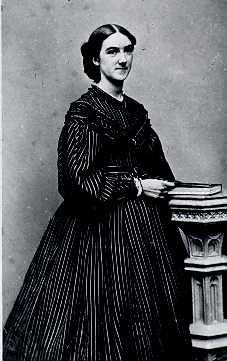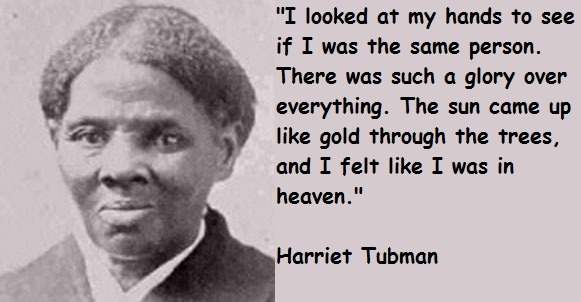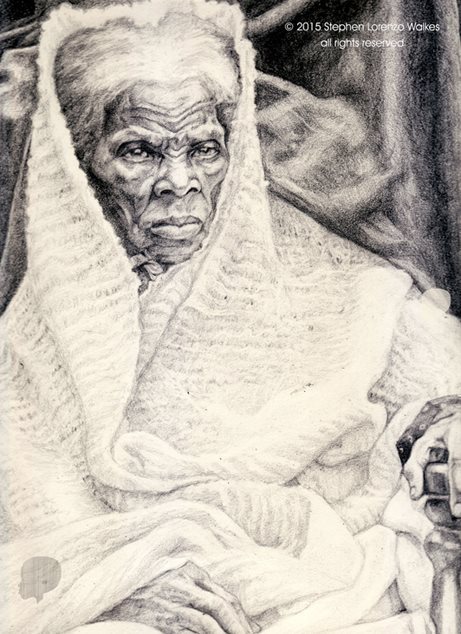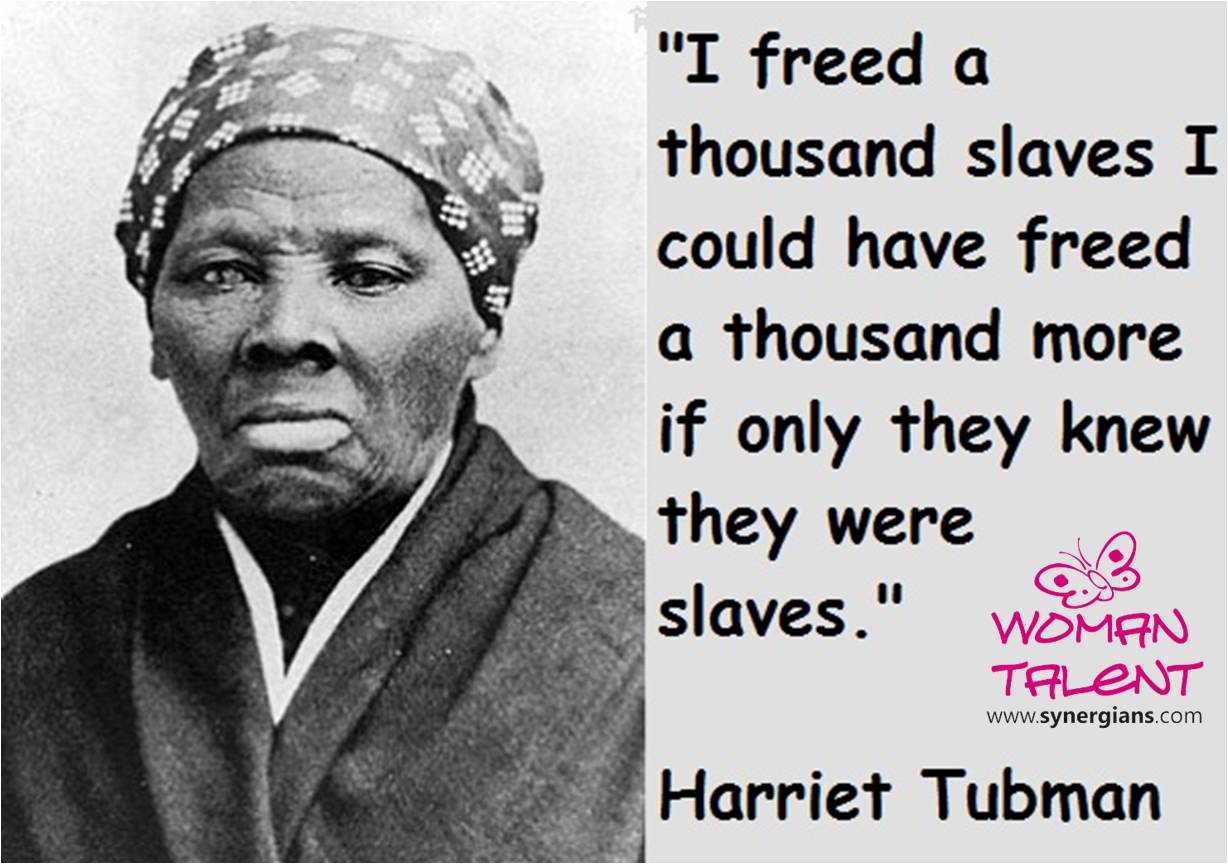They Called Her
Moses
HARRIET TUBMAN
By MARGARET BARTON
DRIGGS
Some likened her
to Joan of Arc for her charisma and simple faith. She had dreams and visions,
and extraordinary things happened to her. She led a charmed life through
incredible dangers.
John Brown called
her “General”; Frederick Douglass felt humble in her presence; Queen Victoria
honored her with an invitation to England and the gift of a silk shawl. The
Quaker Thomas Garrett said of her, “If she had been a white woman, she would
have been heralded as the greatest woman of her age.” To her own people she was, simply, “Moses”,
and their haunting spirituals—veiled messages – enlarged the metaphor to sing
of Jordan and the Promised Land.
Harriet Ross
Tubman was an illiterate slave born in the Bucktown district of Dorchester
County on the Eastern Shore of Maryland. She escaped to freedom, alone, in
1849. For the next 11 years she returned to the South 19 times to lead more
than 300 slaves north across the Mason-Dixon Line and sometimes into Canada.
At the junction of
Bucktown, Green Briar, and Bespitch Ferry Roads, 12 miles southeast of
Cambridge, stands a quaint country store. Beside the dot on the map the word
Bucktown appears. Bucktown is not really a town, but a farming district, and
the store’s only patrons seem to be the great white roosters and gray guinea
hens that huddle in its lee on a winter’s day.
Across the road,
long ago, stood another store, once the scene of a terrible drama played out
between slaves and master–perhaps not an uncommon scene for its age, but one
which, unlike so many others, did not escape history. The heroine was a
16-year- old slave girl named Harriet, destined to become as a Moses to her
people.
A marker placed by
the Maryland Civil War Centennial Commission stands in a field on Green Briar
Road just a mile west of the store. Oral tradition has it that this is the site
of the Brodess plantation where Harriet Tubman was born in 1820. Her parents,
Benjamin and Harriet Green Ross, then slaves of Edward Brodess, were the
grandchildren of Negroes who had come shackled from Africa in 1725. They were
Ashanti, of the region by that name in what is now Central Ghana on the west
coast of Africa.
It was a fall
evening in 1835, and the slaves were cleaning up wheat and husking corn. Jim,
the slave of a farmer named Barnett, seeing the chance for escape, ran to the
Bucktown store. Harriet followed him. So did McCracken, the overseer. McCracken
cornered Jim and demanded that Harriet help capture and tie up the runaway.
Harriet refused. Instead, as Jim went out the door, she closed it and stood
against it, blocking McCracken’s pursuit.
The enraged
overseer picked up a 2-pound weight from the counter and hurled it at her,
hitting her in the forehead. The blow nearly killed her, and disabled her for
months. She was left with an ugly scar, and she was never afterwards free of a
strange affliction that caused her to have sudden, unexpected sleeping
seizures.
Harriet had reason
enough to be bitter already. She had seen her sisters Linah and Sophy sold off
the plantation just the year before. She herself was only seven when she was
sent away from her family to care for a baby. “I was so little,” Harriet
remembered, “that I had to sit on the floor and have the baby put in my lap,
and that baby was always in my lap except when it was sleep or when its mother
was feeding it.” She balked at working in the house, resented whippings, and
became known as a sullen, insolent girl, good only for work in the fields. The
idea of escaping took hold early.
Dr. Virgie Lake
Camper, of Cambridge, a descendant of several slave families, recalls that her
grandfather, Martin Lake, many times heard Harriet say that she planned to
escape. But it was not until 1849, after five years of marriage to John Tubman,
a free man, that she finally left.
For years she had
hoarded her meager earnings from hiring out, and selling vegetables with the
idea of buying her freedom, only to find that her value had increased far
beyond her ability to pay.
John Tubman, whom
Martin Lake characterized as a weak, timid man, had no interest in Harriet’s
desire to be free. Ironically, it was through John Tubman that she learned that
she already had a possible claim to freedom. A clause in the will of her mother’s
former owner, had left Harriet’s mother to a Mary Pattison “to serve her and her issue” until the slave
should become 45. The phrase seemed to signify manumission (formal
emancipation), but was not clearly enough worded to be interpreted as such in
the courts of that day. So Harriet’s
mother and all her children remained slaves. The knowledge that the whole
family could have been free but for a technicality, rankled most in Harriet,
who had already suffered so many indignities and disappointments. Her bitterness
and determination to escape intensified.
Then came rumors
that Harriet and two of her brothers were to be sold to a cotton plantation in
the deep South. At last, Harriet fled but, legend has it, not before stopping
by a window of the house where her parents were working to sing: “I’m bound to
leave you/Bound for Jordan’s other side.” With full knowledge of her meaning
they went on working as if nothing had happened, while their daughter slipped
away.
In the years
before Edward Brodess had come of age, Harriet had served his administrator,
Dr. Anthony C. Thompson, who hitched her to a plow and proudly showed her off
to his friends as being strong as any man.
Now, she put this strength, as well as her knowledge of nature, to its
best use. She followed the North Star and observed on which side of the trees
the moss grew. With the guidance of an unknown Quaker woman in Dorchester
County, she found her way to Philadelphia and freedom via the Underground
Railroad. Once there, she did not turn her back on the past. Instead, she bent
all her efforts toward rescuing those she had left behind.
“I was free and
they should be free,” she said. “I would
make a home in the North and bring them there.”
In the decade that followed, Harriet returned to Dorchester County time
and time again, swiftly and silently empting the county’s plantations of their
slaves.
When the chanting
of “Steal Away,” “Go Down Moses,” and “I Looked Over Jordan” went up among the
slaves and continued for days, and spread from hut to hut, from house to house
and from plantation to plantation, it was understood, but never said, that
Harriet was on her way. Those who could were to steal away to the designated
spot on the first of the month or at the new moon, and she would lead them
away. She had no chariot, not could she part rivers, but she had her own two
good legs and knowledge of the woods and the route, and of people who helped
along the way. She would come in the night, gather up her charges and leave
again quickly. It is said that she inspired the great spiritual “Swing Low,
Sweet Chariot” – words indeed well suited for passing along the information
that Harriet was making another swing through the South.
In her heart,
Harriet carried the same kind of wrath that made Moses break the tablets. She
carried a shotgun with her on her missions, and she would say to her charges,
“If you don’t follow me when I go out, I’m going to kill you. Go forward and live or turn back and die.”
They always went. Along the Underground Railroad it was boasted that Harriet’s
train never ran off the track and she never lost a passenger.
Echoing Patrick
Henry’s denunciation of England’s rule in America, Harriet said of herself and
for all her race: “There’s two things I’ve got a right to and these are death or
liberty; one or the other I mean to have.
No one will take me back alive. I shall fight for my liberty and when
the time is come for me to go, the Lord will let them kill me.” But by the
grace of God and her own special genius, the time never came.
In 1857, with the
financial backing of Senator William Henry Seward, she bought a farm in Auburn,
New York, and settled her parents there. Later, Seward, as Secretary of State,
petitioned Congress in vain in her behalf for compensation for her wartime
services.
During the Civil
War she served as spy, nurse, and liaison between the Union Army and freed
slaves. As a spy, she penetrated
Confederate lines, leading raids that destroyed Confederate property and
liberated slaves. As matron of the Colored Hospital at Fort Monroe, Virginia,
she improved sanitary conditions, reorganized the kitchen, and expedited the
flow of supplies.
After the war she
returned to Auburn to establish a home for aged and needy blacks. She
participated in the establishment of the African Methodist Episcopal Zion
Church, supported the temperance movement, and worked on behalf of women’s
suffrage. Having given everything she owned to help her people, she died
penniless in March, 1913, at the age of ninety-three, a free American, surrounded
by people she had delivered from bondage and helped to a better life. Her death
made headlines in newspapers around the world.
Harriet Tubman’s
lifetime of courage reached beyond the slaves she helped. Dr. Virgie Camper’s
grandfather, Martin Lake, inspired by Harriet’s success, escaped on his own. Knowing the way himself,
he did not wait for Harriet.
Lake made at least
three attempts before he succeeded. Usually after a thwarted attempt, he would
be whipped. Other slaves administered the whipping so that they would learn a
lesson from it. After the whipping they were made to rub salt into the wounds.
There were no hard feelings, Martin told his sons, because slaves were forced
to do what they did.
“Now my granddaddy
was a strong, big, sort of wicked man,” says Virgie Camper. “He wasn’t afraid.
Daddy used to tell us how his father would walk at night and sleep during the
daytime in culverts. A culvert under a bridge was the only safe place to be.
Once, he hid up in a hollow tree. His pursuers trailed him to the foot of the
tree with dogs and built a fire at the bottom to smoke him out. He didn’t say
what he did so he wouldn’t sneeze, but he didn’t sneeze, and he stayed in
there.” His pursuers eventually gave up and left.
During the Civil
War Martin Lake served in the Union Army. Afterwards he returned to Bucktown
and settled there. He married Amanda
Camper who, born in 1858, was many years younger than he. Their only son,
Monroe Lake, was 12 years old when his father died. “So my daddy,” says Mrs.
Camper, “hired out and took care of his mother and sisters. He hired out to the Brodess family faithfully
through a difficult period in their lives. “And as a result of that, the
Brodesses gave them each a little piece of land. I think they gave each child
an acre.” The land is on Green Briar Road, adjoining the land where Harriet
Tubman was born.
Monroe, too, sank
his roots deep into Bucktown. He worked the Brodess farm and surrounding land,
buying up, whenever he could, land that Martin and Harriet had worked in
slavery. When he died in 1975, he left a substantial amount of the Brodess
plantation to his surviving sons.
Left on the land
now are few traces of the human struggle that took place there in the last
century. There are the Negro graves, separate from the white, many of them
unmarked and forgotten; the faces of the living, with familial traces of those
Pinders, Campers, Clashes, Jacksons, Lakes, and others who worked side by side
with Harriet; there is the little church. And there is a tradition stronger
than any trace left on the land.
On the third
Sunday of every June, old residents of the Bucktown district gather at Bazel’s
Methodist Episcopal Church for a service in memory of Harriet Tubman. It is one
of the few times in the year that the old church is open now that the black
population, with the exception of the Lake family, has moved away.
Addie Clash Travers,
a retired businesswoman and civic leader, established Harriet Tubman Day in
1970, after being inspired by reading about Harriet’s heroism. Mrs. Travers,
born in Bucktown in 1913, two months before Harriet died in Auburn, New York,
is related to Harriet through the Rosses.
















